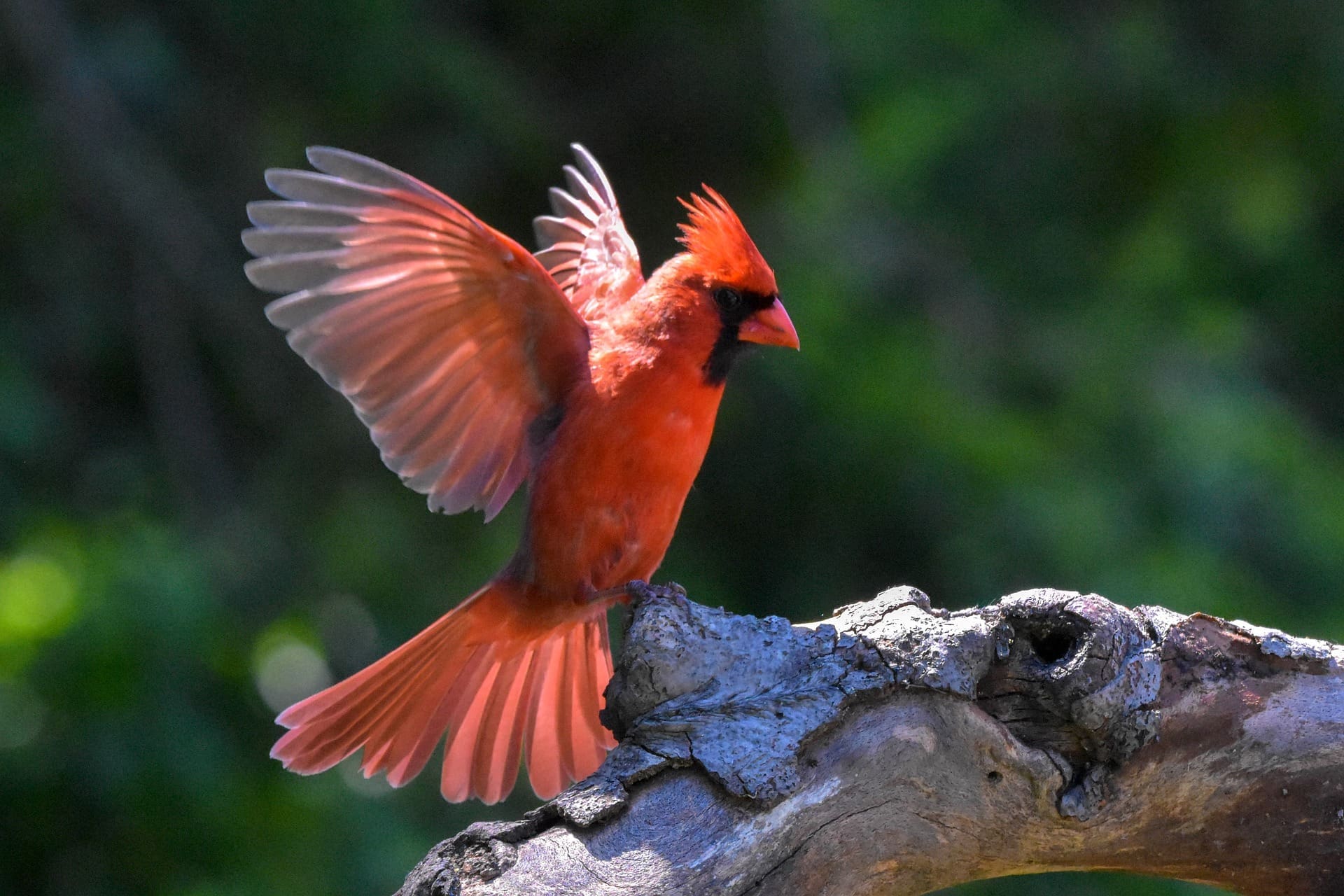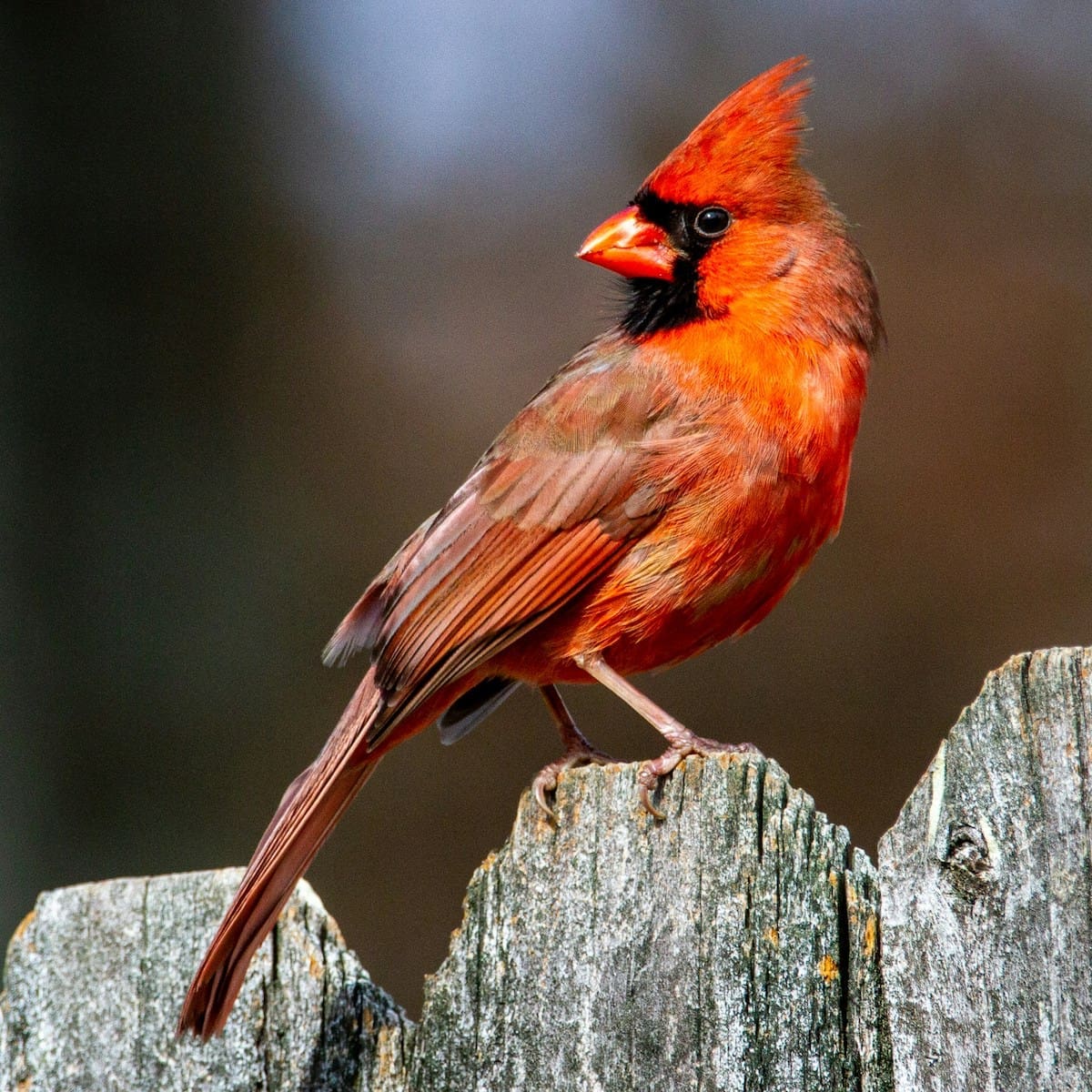What instantly recognizable songbird holds seven state titles and has the crown to prove it?
The Northern Cardinal!

The iconic red plumage of the Northern Cardinal is a staple of backyard gardens across the Eastern United States and Mexico, and is a rare example of a species thriving amidst the expansion of the built environment. While Cardinalis cardinalis is a marker of springtime in New England, these non-migratory birds make permanent homes in open woodlands, thickets, and backyards, their striking red feathers bringing a welcome burst of color to the white backdrop of northern winters.
When March rolls around, starting the cardinal breeding season, you’ll begin to hear the mating calls of female birds. Some of the most vocal songbirds around, the Northern Cardinal has a wide variety of chirps, whistles, calls, and songs – even duets unique to mated pairs – that serve a range of purposes. Their vocal acrobatics and flashy appearance have made them a favorite among birders and state governments alike. The Northern Cardinal is the state bird of Illinois, Indiana, Kentucky, North Carolina, Ohio, Virginia, and West Virginia – the nation’s most popular choice with 7 state titles.

Hard to miss
Cardinals were originally named for the male bird’s resemblance to the bright red robes and caps of the cardinals of the Roman Catholic Church. In 1983, the “Northern” qualifier was added to differentiate the bird from its Southern cousins, including species like the Yellow Cardinal. Male Northern Cardinals possess those iconic red feathers, while the female is less flamboyant: brown in color with a reddish tint that is most noticeable while in flight. The male’s vibrancy may be useful to attract a mate, but the more neutral brown of the female helps to camouflage the nest during the incubation of eggs and subsequent brooding of chicks. This results in a natural division of parenting duties.

An eventful mating season
Mating calls announce the start of nesting season in early March, and the cardinals’ prolific musical repertoire can be heard through late August or September. Northern cardinals select one mate for the extent of the breeding season and divide up the parenting responsibilities. With the red of the males easily spotted by predators, only the females sit on the nest. The males are resigned to foraging, allowed back to the nest only when a chirp from the female signals the coast is clear.
Cardinal chicks feed primarily on nutrient-rich insects until they leave the nest 10 days after hatching. After the chicks fledge, or grow their flight feathers, the parents continue to feed the young birds for another month or more, transitioning them to a granivorous diet consisting of seeds and grain – easily shelled by their conical, orange beaks – with the occasional berry or insect. Around June, the cardinal parents are free to start their next brood. Northern cardinals often raise two rounds of chicks, ranging from 1-3 eggs per nest for a total of 3-5 eggs per season. Territories are fiercely defended by males, who are often seen attacking their own reflection in windows and mirrors. You can’t be too careful!
When the mating season winds down in late summer, it is not uncommon to spot the occasional bald cardinal, but don’t worry, the birds aren’t sick! Cardinals usually replace their crest feathers gradually throughout the summer, but sometimes they’re all molted at once, exposing their dark skin. The effect is only temporary, with their notable crest growing back in a matter of weeks.

A well-adapted species
While most species around the world are confronting immense challenges and population declines as a result of urbanization and global warming, the range and population of Northern Cardinals is actually increasing. The growth of suburbs has increased their nesting habitat, as the birds favor the thick branches of bushes and shrubs, common in woodland edges and backyard gardens. Their expansion has been aided by the presence of birdfeeders, providing cardinals with an easy food source in urban areas that give them an advantage over most native bird species. (Sunflower seeds are a cardinal’s preferred snack, for anyone looking to attract these beautiful birds.)
Cardinals may be more protected in urban areas with an absence of larger predators, but they still play a role in their local ecosystems. They serve as seed-dispersers as they forage for food, and can become a meal for the occasional predator. Domestic cats and dogs do pose a threat to them, as do hawks and owls, while small snakes, squirrels, chipmunks, and blue jays tend to go after cardinal eggs. However, cardinals have proved exceptionally adaptable in the age of human expansion. Their range has crept northward to Maine and southern Canada in the past 100 years as temperatures increase, with Northern Cardinals now numbering around 130 million.
While not a species of concern, may we continue to pay attention to and take inspiration from the Northern Cardinal, a proven adapter to the Anthropocene and a gentle backyard reminder of the beautiful sights and sounds of the natural world.
With a spring in my step,
Ryan

Ryan Pagois is a climate advocate and systems thinker serving as an Associate Director at Built Environment Plus, helping to drive sustainable building solutions in MA. He is passionate about urban ecology, carbon balance, and rewilding cities. He is excited to pursue a Masters of Ecological Design at the Conway School starting this fall, to explore how low-impact urban development can be our greatest climate solution and community resilience tool. He grew up in Minnesota and studied environmental policy and international relations at Boston University.
Sources and Further Reading:
https://www.allaboutbirds.org/guide/Northern_Cardinal/lifehistory#conservation
https://www.audubon.org/field-guide/bird/northern-cardinal
https://www.birdsandblooms.com/birding/state-birds-facts/
http://www.biokids.umich.edu/critters/Cardinalis_cardinalis/
https://www.audubon.org/news/10-fun-facts-about-northern-cardinal


